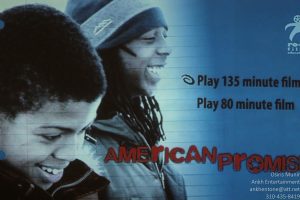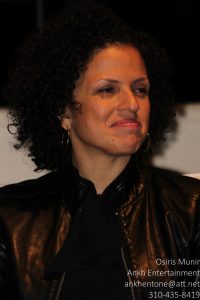 In tribute to February’s upcoming, “Black History Month†and the simultaneous celebration of Dr. Martin Luther King’s birthday, “American Promise†delivers a significant and haunting truth about America and its lack of ability in bringing a tighter focus on manhood, and more specifically black manhood. The self- produced, Joe Brewster, Michele Stephenson, documentary cover the lives of two Brooklyn based, African American families over a period of thirteen years. Idris, who is the son of Brewster and Stephenson, and best friend, Seun both have the experience of a middle-class upbringing. “American Promise†takes on an interesting perspective as it follows Seun and Idris through, grade school puberty and eventually young men on the way to graduating from Manhattan’s Dalton School. Dalton, known for their ability to churn out selected candidates by use of a rigorous educational program, is set up especially for genius bound students, promised a delicious slice of the American pie. Our educational systems imbalances become evident, as both young men show signs of distress, lack of interest and misunderstandings while attending Dalton. Both families values are soon tested, as Idris and Seun face the realities of cultural differences, being teenagers and eventually becoming self-sustaining adults.
In tribute to February’s upcoming, “Black History Month†and the simultaneous celebration of Dr. Martin Luther King’s birthday, “American Promise†delivers a significant and haunting truth about America and its lack of ability in bringing a tighter focus on manhood, and more specifically black manhood. The self- produced, Joe Brewster, Michele Stephenson, documentary cover the lives of two Brooklyn based, African American families over a period of thirteen years. Idris, who is the son of Brewster and Stephenson, and best friend, Seun both have the experience of a middle-class upbringing. “American Promise†takes on an interesting perspective as it follows Seun and Idris through, grade school puberty and eventually young men on the way to graduating from Manhattan’s Dalton School. Dalton, known for their ability to churn out selected candidates by use of a rigorous educational program, is set up especially for genius bound students, promised a delicious slice of the American pie. Our educational systems imbalances become evident, as both young men show signs of distress, lack of interest and misunderstandings while attending Dalton. Both families values are soon tested, as Idris and Seun face the realities of cultural differences, being teenagers and eventually becoming self-sustaining adults.
Dr. Martin Luther King, Malcolm X, William B. Dubois and Frederick Douglas, amongst others saw the need to direct thought and attention to the development of clearer roles, for responsible community leaders. Social activist, both King and Malcolm X had sincere and honest concerns for the image, safety, and protection of young African-American men. The event proved that Dr. King’s dream is now a shared optimism by these two filmmakers.[youtuber youtube=’http://www.youtube.com/watch?v=gVTgHkaJuH4&feature=youtu.be’]
The after panel hosted by LA Time’s, Sandy Banks and a diverse mix of prominent community leaders,  Rev. Sonja Dawson, New Mt. Calvary Missionary, Educator Dr. Christopher J. Jiminez , Pasadena City College, social activist, Dominique Di Prima, First A.M.E’s, Rev. J. Edgar Boyd and “American Promise†producers, director’s Joe Brewster and Michele Stephenson. The concerned group expressed to the audience their most basic viewpoints, regarding the age-old issue of†how the education and proclamation of America’s, dark child of the sun, the black man, should be managed.
 “American Promise†is the winner of 2013 Sundance Film Festival and the U.S. Documentary Special Jury Award. “American Promise†is co-produced by Rada Film Group, ITVS and POV’s Diverse Voices Project. Funding of the project is provided by the Corporation for Public Broadcasting (CPB). Part of American Graduate: Let’s Make It Happen, made possible by CPB. Produced in association with American Documentary | POV. A co-presentation with the National Black Programming Consortium. To coincide with the POV documentary, Spiegel & Grau will publish Promises Kept: Raising Black Boys to Succeed in School and in Life, by Joe Brewster and Michèle Stephenson with Hilary Beard.  “American Promise†is set to air on POV, at 10:00PM EST, on February 3. Â
“American Promise†is the winner of 2013 Sundance Film Festival and the U.S. Documentary Special Jury Award. “American Promise†is co-produced by Rada Film Group, ITVS and POV’s Diverse Voices Project. Funding of the project is provided by the Corporation for Public Broadcasting (CPB). Part of American Graduate: Let’s Make It Happen, made possible by CPB. Produced in association with American Documentary | POV. A co-presentation with the National Black Programming Consortium. To coincide with the POV documentary, Spiegel & Grau will publish Promises Kept: Raising Black Boys to Succeed in School and in Life, by Joe Brewster and Michèle Stephenson with Hilary Beard.  “American Promise†is set to air on POV, at 10:00PM EST, on February 3.  
http://www.pbs.org/pov/americanpromise/trailer.php#.UttPaLSIaM8.
https://www.gse.upenn.edu/equity/sites/gse.upenn.edu.equity/files/publications/bmss.pdf
Black History Month is a month set aside to learn, honor, and celebrate the achievements of black men and women throughout history. Since its inception, Black History Month has always been celebrated in February. Find out how Black History Month originated, why February was chosen, and what the annual theme for Black History Month is for this year.
Origins of Black History Month
The origins of Black History Month can be traced back to a man named Carter G. Woodson (1875-1950). Woodson, the son of former slaves, was an amazing man in his own right. Since his family was too poor to send him to school as a child, he taught himself the basics of a school education. At age 20, Woodson was finally able to attend high school, which he completed in just two years.
He then went on to earn a bachelor’s and master’s degree from the University of Chicago. In 1912, Woodson became only the second African American to earn a doctorate from Harvard University (W.E.B. Du Bois was the first). Woodson used his hard-earned education to teach. He taught both in public schools and at Howard University.
Three years after earning his doctorate, Woodson made a trip that had a great impact on him. In 1915, he traveled to Chicago to participate in a three-week celebration of the 50th anniversary of the end of slavery. The excitement and enthusiasm generated by the events inspired Woodson to continue the study of black history year-round. Before leaving Chicago, Woodson and four others created the Association for the Study of Negro Life and History (ASNLH) on September 9, 1915. The following year, the ASNLH began publication of the Journal of Negro History.
Woodson realized that most textbooks at the time ignored the history and achievements of blacks. Thus, in addition to the journal, he wanted to find a way to encourage interest and study of black history. In 1926, Woodson promoted the idea of a “Negro History Week,” which was to be held during the second week of February. The idea caught on quickly and Negro History Week was soon celebrated around the United States. With a high demand for study materials, the ASNLH began to produce pictures, posters, and lesson plans to help teachers bring Negro History Week into schools. In 1937, the ASNLH also began producing the Negro History Bulletin, which focused on an annual theme for Negro History Week.
In 1976, the 50th anniversary of the beginning of Negro History Week and the bicentennial of the United States’ independence, Black History Week was expanded to Black History Month. Ever since then, Black History Month has been celebrated in February around the country.
Information on the “Origins of Black History†is taken from www.about.com/Black History Month.